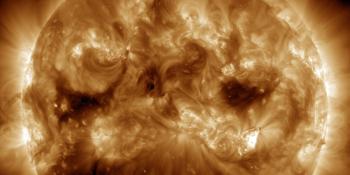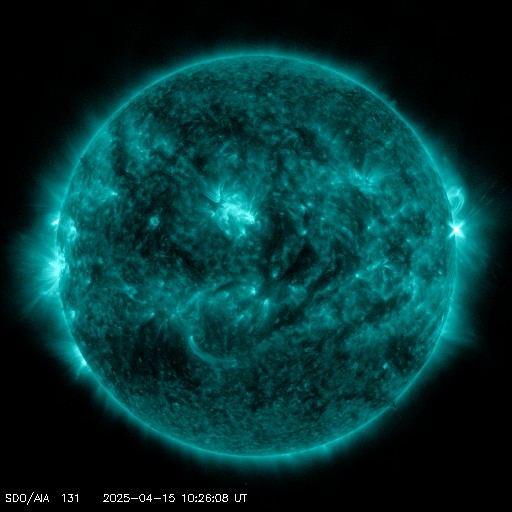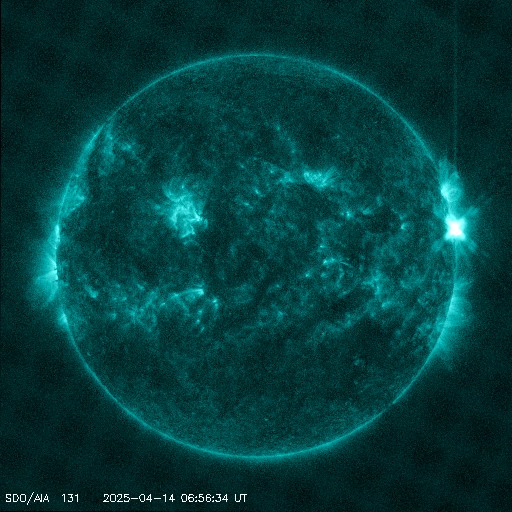Viewing archive of Sunday, 29 February 2004
Solar activity report
Any mentioned solar flare in this report has a scaling factor applied by the Space Weather Prediction Center (SWPC). Because of the SWPC scaling factor, solar flares are reported as 42% smaller than for the science quality data. The scaling factor has been removed from our archived solar flare data to reflect the true physical units.
Report of Solar-Geophysical Activity 2004 Feb 29 2200 UTCPrepared by the NOAA © SWPC and processed by SpaceWeatherLive.com
Joint USAF/NOAA Report of Solar and Geophysical Activity
SDF Number 060 Issued at 2200Z on 29 Feb 2004IA. Analysis of Solar Active Regions and Activity from 28-2100Z to 29-2100Z
Solar activity was very low. Only one flare occurred
during the past 24 hours, a B4 at 0617 UTC from Region 564 (N13W67).
This Region continues to dominate the disk in size and complexity,
but appears to be in slow decline as it approaches west limb. A CME
was observed on the southwest limb by LASCO, beginning at 1230 UTC.
The plane-of-sky speed was estimated to be about 500 km/s. EIT 195
difference images show that the CME must have originated from behind
the solar disk since the associated activity is first seen off the
southwest limb starting at 1200 UTC. The CME is not earthward
directed.
IB. Solar Activity Forecast
Solar activity is expected to be low.
There continues to be a chance, however, for an isolated M-class
event from Region 564.
IIA. Geophysical Activity Summary 28-2100Z to 29-2100Z
The geomagnetic field ranged from quiet to minor storm levels during
the past 24 hours. Although unsettled to active levels predominated,
there was an interval of mostly minor storm level activity between
0900-1500 UTC. Solar wind data show that the activity is being
driven by a high speed stream which is associated with a favorably
positioned coronal hole.
IIB. Geophysical Activity Forecast
The geomagnetic field is
expected to be mostly active, with possible minor storm periods, for
tomorrow (1 March). Unsettled to active conditions are expected for
the 2nd day (2 March), and mostly unsettled should prevail by 3
March.
III. Event Probabilities 01 Mar to 03 Mar
| Class M | 30% | 30% | 30% |
| Class X | 05% | 05% | 05% |
| Proton | 05% | 05% | 05% |
| PCAF | green | ||
IV. Penticton 10.7 cm Flux
Observed 29 Feb 110 Predicted 01 Mar-03 Mar 110/105/100 90 Day Mean 29 Feb 112
V. Geomagnetic A Indices
Observed Afr/Ap 28 Feb 014/020 Estimated Afr/Ap 29 Feb 016/030 Predicted Afr/Ap 01 Mar-03 Mar 020/025-015/020-012/015
VI. Geomagnetic Activity Probabilities 01 Mar to 03 Mar
| A. Middle Latitudes | |||
|---|---|---|---|
| Active | 40% | 35% | 30% |
| Minor storm | 25% | 20% | 15% |
| Major-severe storm | 10% | 05% | 05% |
| B. High Latitudes | |||
|---|---|---|---|
| Active | 35% | 35% | 30% |
| Minor storm | 30% | 25% | 20% |
| Major-severe storm | 20% | 20% | 10% |
All times in UTC
Currently there's no noteworthy space weather
Latest news
Latest forum messages
2025/04/12-13 Filament CMEs 2025/04/16 G2 Watch 68Incoming & Unnumbered Active Regions 1715Space Weather Memes 692Filaments and prominences 63AR4062 16
More topicsSupport SpaceWeatherLive.com!
A lot of people come to SpaceWeatherLive to follow the Sun's activity or if there is aurora to be seen, but with more traffic comes higher server costs. Consider a donation if you enjoy SpaceWeatherLive so we can keep the website online!

Latest alerts
10:39 UTC - Solar flare
Moderate M1.52 flare from sunspot region 4055
10:24 UTC - Radio Blackout
Minor R1 radio blackout in progress (≥M1 - current: M1.52)
Monday, 14 April 2025
23:15 UTC - Geomagnetic activity
Active geomagnetic conditions (Kp4) Threshold Reached: 23:01 UTC
07:09 UTC - Solar flare
Moderate M4.28 flare from sunspot region 4055
06:48 UTC - Radio Blackout
Minor R1 radio blackout in progress (≥M1 - current: M1.53)
Space weather facts
| Last X-flare | 2025/03/28 | X1.1 |
| Last M-flare | 2025/04/14 | M4.2 |
| Last geomagnetic storm | 2025/04/06 | Kp5 (G1) |
| Spotless days | |
|---|---|
| Last spotless day | 2022/06/08 |
| Monthly mean Sunspot Number | |
|---|---|
| March 2025 | 134.2 -20.4 |
| April 2025 | 128.8 -5.4 |
| Last 30 days | 129.1 -15.1 |





